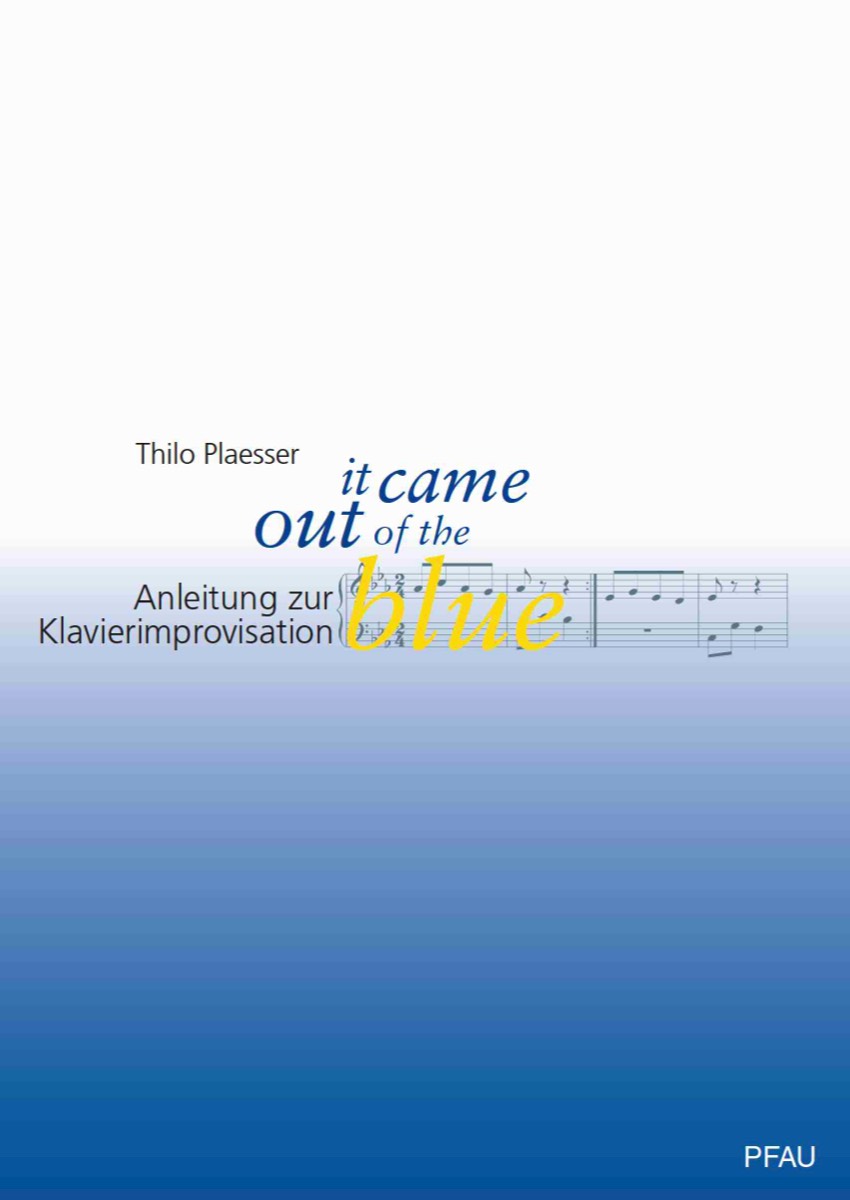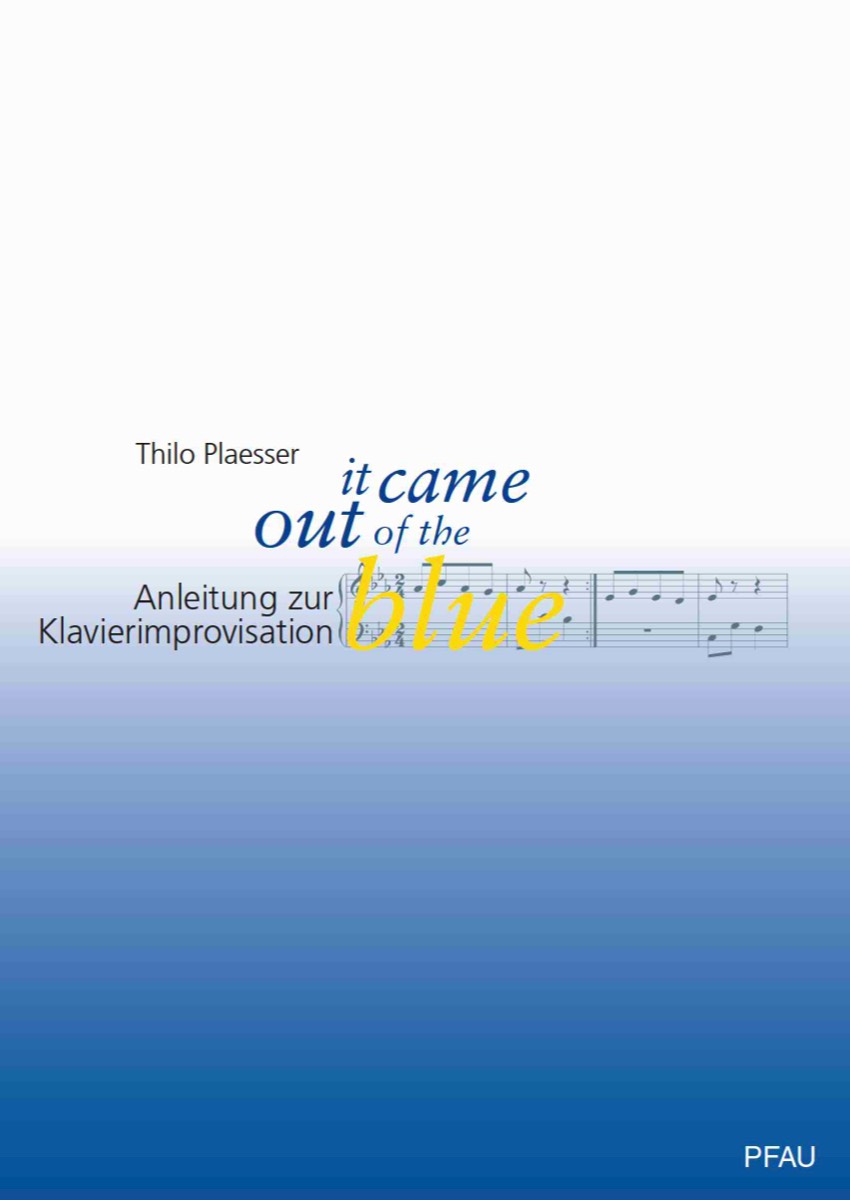
"It came out of the blue"
Anleitung zur Klavierimprovisation
Auch für BAYAN geeignet !
Pfau-Verlag, Saarbrücken, 2006 , 2.Auflage 2011
ISBN 3-89727-321-7
109 Seiten, br. 18.00 EUR
Das Buch ist im Buch- und Musikalienhandel erhältlich oder online zu bestellen unter:
Amazon
JPC
Pfau-Verlag
Bodensee Musikversand
"it came out of the blue" - Anleitung zur Klavierimprovisation
"aus heiterem Himmel" dieses engl. Sprichwort wird gebraucht, wenn etwas völlig Unerwartetes passiert. Improvisation rechnet ja mit dem Unerwarteten. Der Improvisator kann sich aber darauf vorbereiten, dem Unerwarteten offen und kreativ gegenüber zu stehen.
Unabhängig von Stilrichtungen vermittelt dieses Buch einen zeitlosen Umgang mit den musikalischen Parametern. Jedes Kapitel enthält Improvisationsvorlagen, die dem Leser helfen, das Erlernte umzusetzen. Die Vorlagen im Anhang des Buches regen dazu an, die erlernten Elemente sinnvoll und kreativ zu einer individuellen modernen Tonsprache zu kombinieren. Kurze, aufeinanderfolgende Schritte mit vielen Notenbeispielen führen zum selbständigen Improvisieren sowie zum kreativen Begleiten.
Dieses Buch richtet sich an alle Musiker, ganz gleich ob sie sich professionell oder in ihrer Freizeit mit dem Klavier oder anderen Tasteninstrumenten beschäftigen. Angesprochen werden vor allem Klavierschüler, die über Grundkenntnisse der allgemeinen Musiklehre verfügen sowie Klavierlehrer, Pianisten, Schulmusiker oder Organisten. Besonders klassisch ausgebildete Musiker, die Material außerhalb der Jazzmusik suchen, werden hier fündig. Das Buch kann auch dem Anfänger wertvolle Dienste leisten, da die improvisatorischen Fähigkeiten nicht unbedingt mit dem Ausbildungsstand einhergehen müssen.
109 Seiten, br.
Beispielseiten siehe hier
Rezensionen siehe hier
______________________________________________________________________________________________

"It came out of the blue"
Instructions for piano improvisation -
Also suitable for Bayan !
Pfau-Verlag, Saarbrücken, 2006 , 2nd edition 2011
ISBN 3-89727-321-7
109 pages, br. 18.00 EUR
The book is available in book and music stores or can be ordered online at:
Amazon
JPC
Pfau-Verlag
Bodensee Musikversand
Attention:
The book is written in German!
An English edition is being planned
"It came out of the blue"
the English saying for when something completely unexpected happens. Improvisation, of course, reckons with the unexpected. The musical improviser can, however, prepare himself to be open and creative in the face of the unexpected.
Piano improvisation is not limited to jazz music. Plenty of classical musicians are looking for material for piano improvisation in other fields of music than jazz. Every type of music – be it classical, romantic or jazz, Bach, Beethoven, Britten or Bartok - uses the 12 notes and the resulting intervals, scales and chords, along with rhythm Now a unique guide has been written, based on experience, which offers ideas and encouragement as well as providing sound advice on how to develop your own means of expression. „It came out of the blue“ is a modern approach to dealing with timeless elements.
This textbook is a unique teaching and learning aid for piano teachers and students, classical pianists and school music teachers. It is a tried and tested, unique approach.
This approach provides a modern, contemporary tone language based on the independence of the musical parameters (intervals, scales, chords). The reader’s own branch of music or the style of music to which he or she aspires is not important as the book sets out to deliver universally applicable improvisational advice. The book is not based on traditional major/minor harmonics, but helps the student to shed old listening habits. Short modules - each building on the previous one - and detailed notated examples help the reader learn to improvise with confidence and compose creative accompaniments.
Each section contains improvisation models which help the reader to put into practice what he or she has learned. The models in the Appendix encourage the reader to combine meaningfully and creatively the elements of what he or she has learned into an individual, modern tone language. These elements include, among other things, motifs, themes, ostinati, scales, rhythms and form models. Yet this modern tone language works well with traditional tunes as well, so all sorts of tunes have been included in the exercises and in the Appendix, including in particular English, Irish, Scottish and Welsh folk songs.
Example pages see here
Reviews see here
_______________________________________________________________________________________

